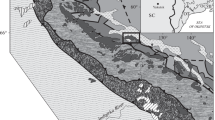Abstract
The late Variscan granitoids of the NW Bohemian massif (northeast Bavaria, west Bohemia) constitute four partly contiguous granitoid complexes: Fichtelgebirge, northern Oberpfalz, Waidhaus-Rozvadov and Bor, incorporating more than 20 intrusive units. Based on gravity data, the granites can be modeled as steeply inclined slab- and wedge-like bodies with thicknesses between 2 and 8 km. A rough estimate of the total volume of the granites is approximately 18 000 km3. Within the four areas named above, composition ranges from less evolved dioritic rocks, known as the redwitzite suite, to highly evolved granites. The redwitzites comprise metaluminous rocks with dominant I type features. These rocks yield aberrantly old Rb–Sr ages (545–415 Ma), low initial Sr ratios (0.706–0.708) and high and variable ɛNd(T) values (1 to –4). Sr–Nd isotopes of the redwitzites show contamination trends towards the granites suggesting mixing between mantle magma and crustal granitic melts. An older plutonic association (granites of Bor, Leuchtenberg, Weissenstadt-Marktleuthen, Zainhammer) is mildly peraluminous, displaying features of both I and S type granitoids. These granites are characterized by Lower Carboniferous ages (Rb–Sr, K–Ar, U–Pb), low to intermediate initial Sr ratios (0.707–0.708) and high ɛNd(T) values (–2 to –4) which overlap with those of paragneisses from the Zone of Erbendorf-Vohenstrauss (ZEV) and from the western part of the Teplá Barrandian. It is postulated that the older granites were formed either by partial melting of ZEV or Teplá Barrandian crust, or alternatively, of preexisting mature crust contaminated by mantle material. The younger granites are strongly peraluminous and of S type. They yield Upper Carboniferous Rb–Sr and K–Ar ages and exhibit a range towards high initial Sr ratios (0.710–0.720) and low ɛNd(T) values (–4 to –8). Similar values are found in Moldanubian paragneisses and in Saxothuringian metasediments, both of which provide potential source–rock lithologies for these granites.
The age and isotope data discussed herein suggest episodic rather than continuous magmatic activity. From a combination of field and analytical data, a three-stage cycle of granitoid intrusion is proposed: (a) a first phase (∼350–325 Ma) of two contrasting magma types coexisting in a close spatial context, the redwitzites (phase Ia) and the older granites (phase Ib), (b) a second phase with emplacement ages of 315–310 Ma comprising all younger granites of the northern Oberpfalz and the Waidhaus-Rozvadov complex and (c) a third phase with emplacement ages of 305–295 Ma restricted to the Fichtelgebirge.
Similar content being viewed by others
Author information
Authors and Affiliations
Additional information
Received: 16 June 1996/Accepted: 24 November 1996
Rights and permissions
About this article
Cite this article
Siebel, W., Trzebski, R., Stettner, G. et al. Granitoid magmatism of the NW Bohemian massif revealed: gravity data, composition, age relations and phase concept. Geol Rundsch 86 (Suppl 1), S45–S63 (1997). https://doi.org/10.1007/PL00014665
Issue Date:
DOI: https://doi.org/10.1007/PL00014665



